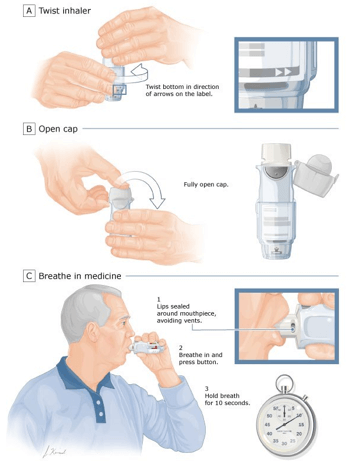A nurse is reinforcing teaching with a client who is about to start using an albuterol metered-dose inhaler.
Which of the following instructions should the nurse include in the teaching?
Tilt your head forward while inhaling.
Take three quick breaths while depressing the canister.
Close your mouth around the mouthpiece.
Exhale immediately after inhaling.
The Correct Answer is C
Albuterol is a bronchodilator medication that is commonly delivered through a metered-dose inhaler (MDI) to treat asthma and other respiratory conditions. Proper inhaler technique is crucial for effective delivery of the medication to the lungs.
Option (a) is incorrect because the client should actually tilt their head back slightly and breathe out fully before inhaling the medication.
Option (b) is incorrect because the client should take a slow, deep breath in while depressing the canister once.
Option (d) is incorrect because the client should hold their breath for 10 seconds after inhaling the medication to allow it to reach the lungs.
Therefore, the correct instruction for the nurse to include in the teaching is to instruct the client to close their mouth around the mouthpiece of the inhaler to ensure that the medication is delivered directly to the lungs.

Nursing Test Bank
Naxlex Comprehensive Predictor Exams
Related Questions
Correct Answer is A
Explanation
When administering oral medications, the nurse should verify the medication three times with the medication administration record to ensure that the correct medication is being given to the correct client at the correct time. This is known as the "three checks" and is an important step in preventing medication errors.

Correct Answer is B
Explanation
Tranylcypromine is a monoamine oxidase inhibitor (MAOI) medication used to treat depression. MAOIs inhibit the activity of the enzyme monoamine oxidase, which helps regulate the breakdown of certain neurotransmitters, including tyramine. Tyramine is typically broken down by monoamine oxidase, but when taking an MAOI, the enzyme's inhibition can lead to an excessive accumulation of tyramine in the body.
Tyramine-rich foods, such as aged cheeses, cured meats, and certain fermented or pickled foods, contain high levels of tyramine. Ingesting these foods while taking an MAOI can lead to a sudden release of stored norepinephrine, causing a hypertensive crisis.
Hypertension is a potentially serious adverse effect of MAOI therapy combined with tyramine-rich food ingestion. Symptoms of a hypertensive crisis can include severe headache, palpitations, chest pain, sweating, blurred vision, and in severe cases, it can lead to stroke or other cardiovascular complications.
Hematuria refers to the presence of blood in the urine and is not a known adverse effect of tranylcypromine or related to tyramine-rich food ingestion.
Tinnitus refers to the perception of ringing or noise in the ears and is not a known adverse effect of tranylcypromine or related to tyramine-rich food ingestion.
Hyperglycemia, or high blood sugar levels, is not a known adverse effect of tranylcypromine or related to tyramine-rich food ingestion. However, it's important to note that tranylcypromine may interact with certain diabetes medications, so it's essential to consider the client's overall medical history and potential drug interactions.

Whether you are a student looking to ace your exams or a practicing nurse seeking to enhance your expertise , our nursing education contents will empower you with the confidence and competence to make a difference in the lives of patients and become a respected leader in the healthcare field.
Visit Naxlex, invest in your future and unlock endless possibilities with our unparalleled nursing education contents today
Report Wrong Answer on the Current Question
Do you disagree with the answer? If yes, what is your expected answer? Explain.
Kindly be descriptive with the issue you are facing.
